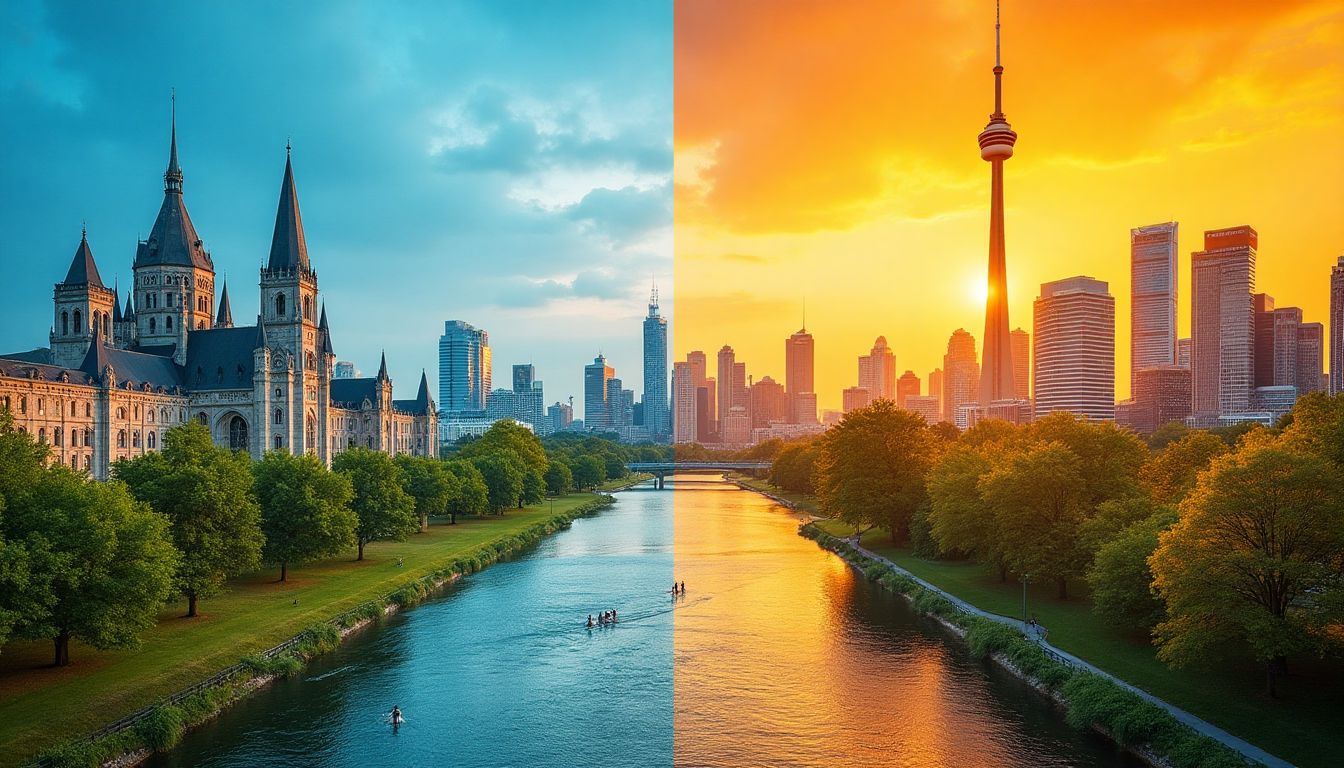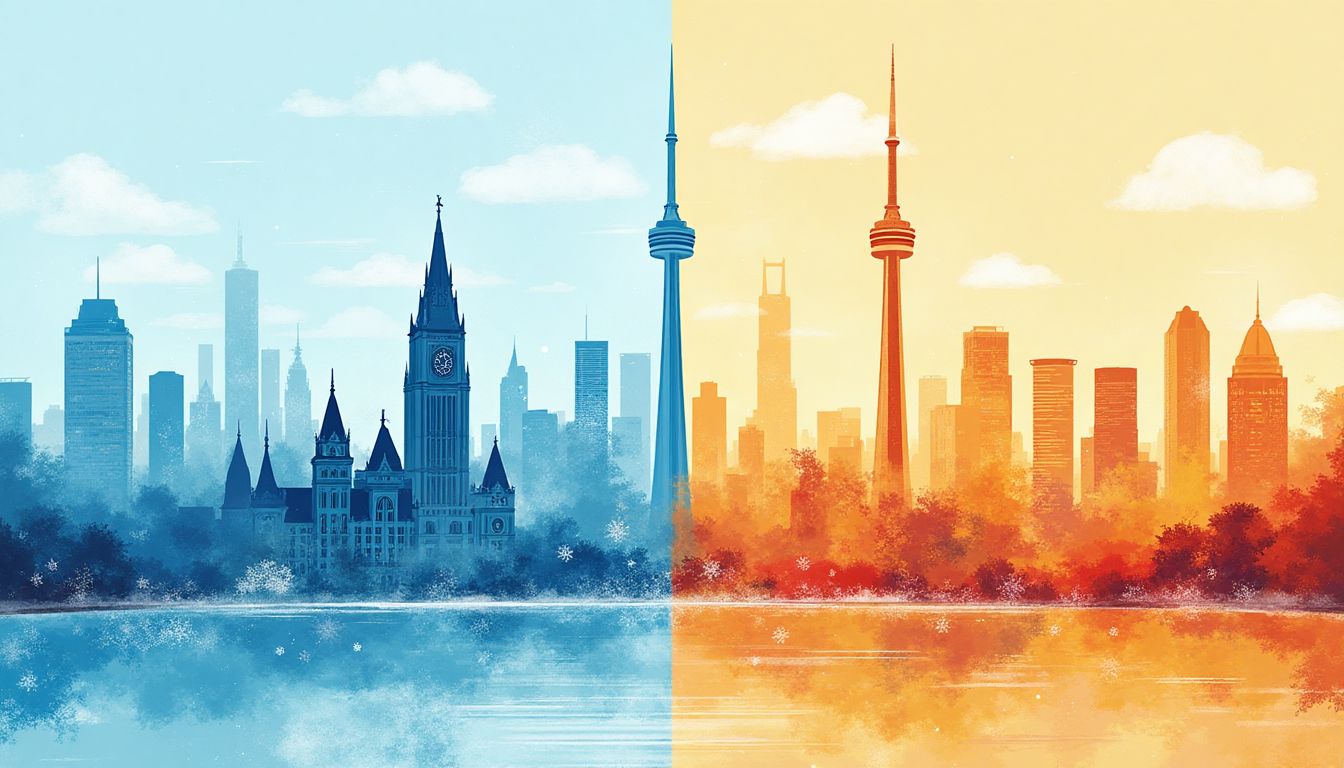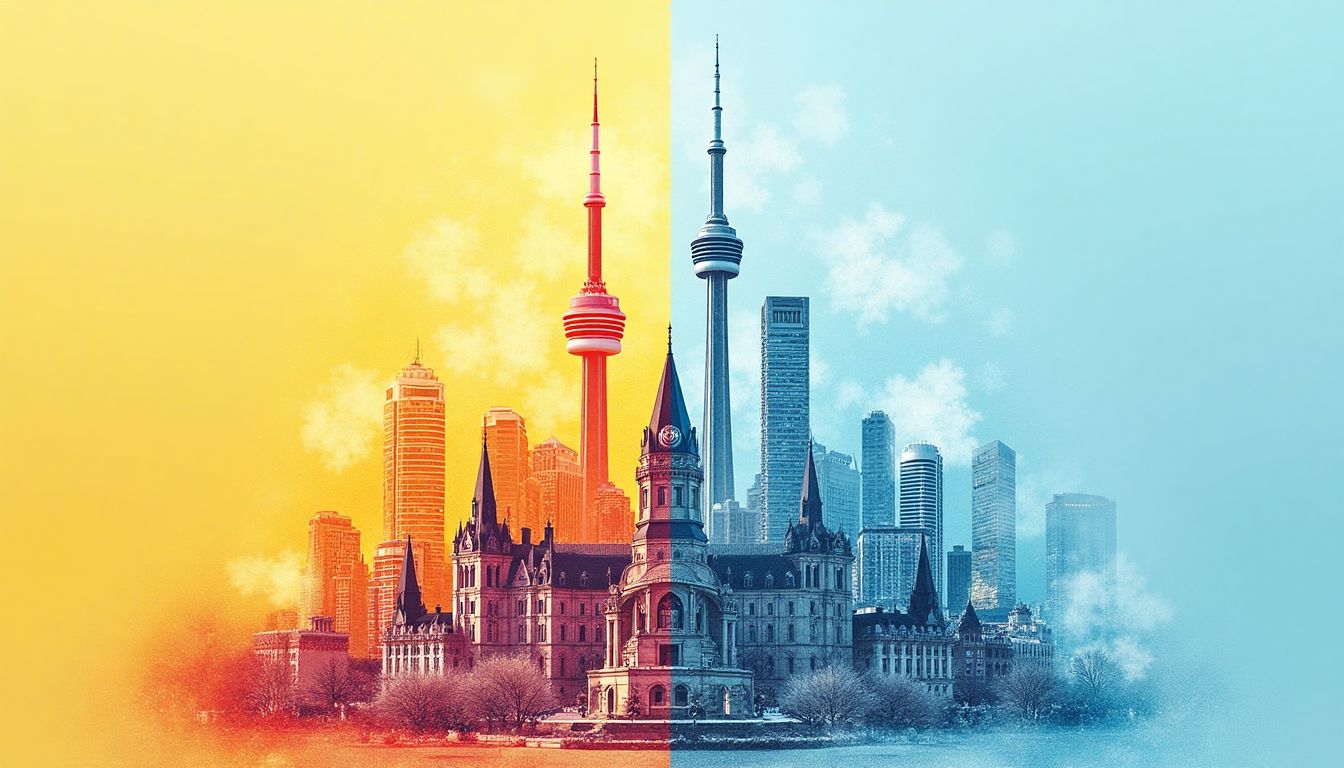Ever wondered if Ottawa is warmer than Toronto? It’s a question that’s sparked debates among Canadians, weather enthusiasts, and even scientists. While both cities are known for their frigid winters and sweltering summers, the devil is in the details. Renowned climatologist David Phillips has often highlighted how geography plays a pivotal role in shaping these cities’ climates. Similarly, urban heat island expert John Stone has explored how cityscapes influence temperature variations. Even Bill Nye, the beloved science communicator, has touched on how climate differences can impact daily life. So, is Ottawa warmer than Toronto? Let’s unravel this meteorological mystery.
For more local insights, check out the Ottawa News Portal and the Toronto News Portal for the latest updates and helpful links.
Geographic and Climatic Differences Between Ottawa and Toronto
When it comes to weather, location is everything. Ottawa, Canada’s capital, sits inland, nestled along the banks of the Ottawa River. Toronto, on the other hand, hugs the shores of Lake Ontario, one of the Great Lakes. This seemingly small difference has a big impact on their climates. Lake Ontario acts like a giant temperature regulator for Toronto, keeping winters milder and summers cooler. Ottawa, without such a massive body of water nearby, experiences more extreme temperatures. Think of it like this: Toronto is the friend who always brings a sweater, while Ottawa is the one who either shivers or sweats, depending on the season.
Historically, Environment Canada data shows that Toronto’s average winter temperature hovers around -3.7°C, while Ottawa dips to a frosty -10.2°C. Summers tell a different story, with Ottawa often hitting highs of 26.5°C compared to Toronto’s 26.1°C. But don’t let those numbers fool you—Toronto’s humidity can make its summers feel like a sauna, while Ottawa’s drier heat feels more like a desert. And let’s not forget snowfall. Ottawa, part of the infamous “Snowbelt,” gets an average of 235 cm of snow annually, while Toronto sees about 122 cm. So, if you’re a snow lover, Ottawa might just be your winter wonderland.
Urban Heat Islands and Their Impact
Ever noticed how cities feel like giant ovens in the summer? That’s the urban heat island effect in action. It’s a phenomenon where cities are significantly warmer than their surrounding rural areas, thanks to human activities and the way we build our urban landscapes. Let’s break it down and see how it plays out in Ottawa and Toronto.
What Are Urban Heat Islands?
Urban heat islands occur when cities replace natural land cover with dense concentrations of pavement, buildings, and other surfaces that absorb and retain heat. Think of it like wearing a black shirt on a sunny day—it’s going to get hot! Add in the heat from cars, air conditioners, and industrial activities, and you’ve got a recipe for a toasty urban environment. The Environmental Protection Agency (EPA) has a great explainer on this if you want to dive deeper.
Toronto’s Urban Heat Effect
Toronto, with its towering skyscrapers and bustling streets, is a prime example of an urban heat island. The city’s dense infrastructure traps heat, making it feel like a sauna during heatwaves. The City of Toronto has been working on strategies to combat this, like planting more trees and creating green roofs. But let’s be honest, when you’re stuck in traffic on the Gardiner Expressway, those trees feel like a distant dream.
Ottawa’s Urban Heat Effect
Ottawa, while less densely packed than Toronto, still feels the heat—literally. The city’s mix of government buildings, residential areas, and sprawling suburbs creates its own heat island. The City of Ottawa has been exploring ways to cool things down, like increasing green spaces and improving public transit. But when the summer sun hits, even the Rideau Canal can’t save you from the heat.
Seasonal Weather Patterns
Weather in Ottawa and Toronto isn’t just about temperature—it’s about how the seasons play out. From bone-chilling winters to sweltering summers, each city has its own unique rhythm. Let’s take a closer look at how the seasons stack up in these two Canadian hubs.
Winter: Ottawa’s Harsh Cold vs. Toronto’s Milder Chill
Winter in Ottawa is like stepping into a freezer—it’s cold, it’s dry, and it’s relentless. The city’s inland location means it doesn’t get the moderating effect of a large body of water, so temperatures can plummet to -20°C or lower. Toronto, on the other hand, benefits from the warmth of Lake Ontario, which keeps things a bit milder. Sure, you’ll still need a parka, but at least you won’t feel like you’re living in a snow globe.
Summer: Ottawa’s Hotter Days vs. Toronto’s Humid Heat
When summer rolls around, Ottawa turns into a heat machine. The city’s inland location means it can get scorching hot, with temperatures often hitting 30°C or higher. Toronto, meanwhile, gets a double whammy of heat and humidity, thanks to Lake Ontario. It’s like walking into a steam room—uncomfortable, but at least you’re not alone. Both cities have their ways of coping, from splash pads to ice cream trucks, but let’s just say air conditioning is a must.
Spring and Fall: Transitional Seasons
Spring and fall are the Goldilocks seasons—not too hot, not too cold, just right. In Ottawa, these seasons are a welcome relief from the extremes of winter and summer. The city’s parks and trails come alive with color, making it the perfect time for a bike ride or a hike. Toronto, with its milder climate, enjoys a longer growing season, so you’ll see flowers blooming and leaves changing well into October. It’s like nature’s way of saying, “Hey, I’ve got your back.”
Historical Weather Events
Weather has a way of leaving its mark on a city, and both Ottawa and Toronto have had their fair share of dramatic weather events. These moments not only shape the cities’ histories but also influence how residents prepare for the future. Let’s take a closer look at some of the most notable storms and how they’ve impacted these two Canadian hubs.
Notable Storms in Ottawa
Ottawa, with its inland location, is no stranger to extreme weather. One of the most infamous events was the 1998 Ice Storm, which left the city paralyzed for days. Freezing rain coated everything in a thick layer of ice, causing widespread power outages and damage to infrastructure. Another memorable event was the 2019 Snowstorm, which dumped over 50 cm of snow in a single day, breaking a century-old record. These events highlight Ottawa’s vulnerability to extreme winter conditions.
Notable Storms in Toronto
Toronto, while generally milder, has also faced its share of weather challenges. The 2013 Flash Flood is a prime example. Torrential rain overwhelmed the city’s drainage system, turning streets into rivers and causing millions in damages. Another significant event was the 2013 Ice Storm, which left thousands without power during the holiday season. These incidents underscore the importance of urban planning and preparedness in the face of extreme weather.
Climate Change and Future Trends
As climate change accelerates, both Ottawa and Toronto are likely to experience more frequent and severe weather events. According to a report by Climate Choices Canada, cities across the country can expect hotter summers, heavier rainfall, and more intense storms. For Ottawa, this could mean even harsher winters and hotter summers. For Toronto, rising temperatures and increased humidity could exacerbate the urban heat island effect. Understanding these trends is crucial for developing strategies to mitigate their impact.
Living in Ottawa vs. Toronto: A Weather Perspective
Weather isn’t just about numbers on a thermometer—it shapes daily life in profound ways. From commuting to energy bills, the climate in Ottawa and Toronto influences how residents live, work, and play. Let’s explore how weather impacts these two cities from a practical perspective.
Daily Life and Commuting
In Ottawa, winter commutes can be a challenge. Heavy snowfall and icy roads often lead to delays and accidents. The city’s winter maintenance efforts are robust, but residents still need to be prepared for slippery conditions. In contrast, Toronto’s milder winters make commuting easier, though the city’s notorious traffic can still be a headache. Both cities face challenges during extreme weather events, but Ottawa’s harsher winters require more resilience from its residents.
Energy Consumption and Heating Costs
Ottawa’s colder winters mean higher heating costs for residents. According to Natural Resources Canada, heating accounts for a significant portion of household energy use in colder climates. Toronto, with its milder winters, sees lower heating costs but higher cooling costs in the summer due to increased use of air conditioning. Here’s a quick comparison:
- Ottawa: Higher heating costs in winter, moderate cooling costs in summer.
- Toronto: Lower heating costs in winter, higher cooling costs in summer.
Recreational Opportunities
Weather also plays a big role in recreational activities. Ottawa’s snowy winters make it a haven for winter sports like skiing, snowboarding, and ice skating. The Rideau Canal Skateway, a UNESCO World Heritage Site, is a must-visit for locals and tourists alike. Toronto, with its milder winters, offers more opportunities for year-round outdoor activities like hiking and cycling. However, its humid summers can make outdoor activities less comfortable. Both cities have unique recreational offerings, but the weather dictates when and how residents can enjoy them.
AI Solutions: How Could AI Tackle This Issue?
Artificial Intelligence (AI) is no longer just a buzzword; it’s a transformative tool that can revolutionize how we understand and respond to climate challenges. When it comes to comparing the climates of Ottawa and Toronto, AI can provide actionable insights, predictive models, and innovative solutions to mitigate the effects of extreme weather. Here’s how AI can make a difference:
Data Collection and Analysis
AI thrives on data, and the first step is to gather comprehensive weather data from sources like Environment and Climate Change Canada, satellite imagery, and IoT-enabled weather stations. Machine learning algorithms can process this data to identify patterns, anomalies, and trends that might be invisible to the human eye. For instance, AI can analyze decades of temperature records to predict future heatwaves or cold snaps in both cities.
Predictive Modeling
Using advanced AI models like neural networks, we can forecast weather patterns with unprecedented accuracy. For example, AI can predict how Lake Ontario’s moderating effect might change over time due to climate change, or how Ottawa’s inland location could lead to more extreme temperature swings. Companies like DeepMind have already demonstrated the potential of AI in weather prediction, achieving results that outperform traditional models.
Urban Planning and Mitigation Strategies
AI can also play a crucial role in urban planning. By simulating different scenarios, AI can help design cities that are more resilient to extreme weather. For instance, AI can suggest optimal locations for green spaces, which can reduce the urban heat island effect in Toronto. In Ottawa, AI could recommend building designs that minimize heat loss during winter. Collaborations with institutions like the Massachusetts Institute of Technology (MIT) could further enhance these efforts.
Public Awareness and Real-Time Alerts
AI-powered apps can provide real-time weather updates and safety alerts to residents. Imagine an app that not only tells you when a snowstorm is coming but also suggests the safest routes for commuting. Companies like IBM Weather are already leveraging AI to offer hyper-local weather forecasts, and similar solutions could be tailored for Ottawa and Toronto.
Action Schedule/Roadmap
Here’s a detailed roadmap to implement AI-driven solutions for climate resilience in Ottawa and Toronto:
- Day 1: Assemble a multidisciplinary team including climatologists, data scientists, urban planners, and AI experts from institutions like University of Toronto and University of Ottawa.
- Day 2: Begin data collection from Environment Canada, satellite imagery, and IoT weather stations.
- Week 1: Develop AI algorithms for weather pattern analysis using platforms like TensorFlow and PyTorch.
- Week 2: Start predictive modeling for Ottawa and Toronto, focusing on temperature, precipitation, and urban heat island effects.
- Month 1: Analyze urban heat island effects in both cities using AI-driven simulations.
- Month 2: Propose mitigation strategies, such as increasing green spaces and optimizing building designs.
- Year 1: Launch AI-powered weather apps for public use, providing real-time updates and safety alerts.
- Year 1.5: Implement urban design changes based on AI insights, such as heat-resistant materials and energy-efficient buildings.
- Year 2: Evaluate the impact of AI-driven solutions and refine models for continuous improvement.
Weathering the Future: A Tale of Two Cities
Ottawa and Toronto, though separated by just a few hundred kilometers, offer a fascinating study in climatic contrasts. While Toronto benefits from the moderating influence of Lake Ontario, Ottawa’s inland location subjects it to more extreme temperatures. These differences are not just academic; they shape the daily lives of residents, influence urban planning, and even impact energy consumption.
As we look to the future, the role of AI in understanding and mitigating these climatic differences cannot be overstated. From predictive modeling to urban planning, AI offers a suite of tools that can help both cities adapt to the challenges posed by climate change. By leveraging AI, we can create more resilient urban environments, ensuring that both Ottawa and Toronto remain vibrant and livable for generations to come.
For more local insights, visit the Ottawa News Portal and the Toronto News Portal. Together, we can harness the power of technology to build a brighter, more sustainable future.
FAQ
Q1: Is Ottawa colder than Toronto in winter?
Yes, Ottawa tends to be colder in winter compared to Toronto. This is because Ottawa is located further inland, away from the moderating effects of large bodies of water like Lake Ontario. Toronto, on the other hand, benefits from the lake’s influence, which helps keep temperatures slightly milder during the colder months. For more detailed weather data, check out Environment Canada’s official website.
Q2: Does Toronto get more snow than Ottawa?
No, Ottawa typically receives more snowfall than Toronto. Ottawa is part of the “Snowbelt,” a region known for heavy snowfall due to its geographic location. Toronto, while it does get snow, experiences less accumulation because of the moderating effect of Lake Ontario. For more insights, visit the Weather Network’s Canada page.
Q3: How does Lake Ontario affect Toronto’s climate?
Lake Ontario plays a significant role in moderating Toronto’s climate. The lake acts as a natural temperature regulator, making winters milder and summers cooler compared to inland cities like Ottawa. This phenomenon is known as the “lake effect.” For a deeper dive into how lakes influence weather, check out this Wikipedia article on lake-effect snow.
Q4: Are summers hotter in Ottawa or Toronto?
Summers are generally hotter in Ottawa, while Toronto experiences more humidity. Ottawa’s inland location means it can get quite warm during the summer months, whereas Toronto’s proximity to Lake Ontario leads to higher humidity levels, making the heat feel more intense. For more on summer weather trends, visit Climate.gov.
Q5: How can AI help improve urban planning for climate resilience?
AI can analyze vast amounts of weather data to predict future climate trends, helping urban planners design cities that are more resilient to extreme weather. For example, AI can suggest ways to reduce urban heat islands or improve drainage systems to handle heavy rainfall. To learn more about AI in urban planning, check out this IBM Watson AI page.
Q6: What are urban heat islands, and how do they affect cities like Ottawa and Toronto?
Urban heat islands are areas in cities that are significantly warmer than their surrounding rural areas due to human activities and infrastructure. Both Ottawa and Toronto experience this phenomenon, but Toronto’s dense urban landscape tends to retain more heat. For more information, visit the EPA’s page on urban heat islands.
Q7: How does climate change impact Ottawa and Toronto?
Climate change is causing more extreme weather events in both cities, including hotter summers, colder winters, and more intense storms. This can lead to challenges like increased energy consumption and infrastructure strain. For the latest on climate change impacts, visit the IPCC’s official website.
Q8: What are some notable weather events in Ottawa and Toronto?
Ottawa has experienced severe ice storms and heavy snowfall, while Toronto has faced significant rainstorms and flooding. These events highlight the importance of being prepared for extreme weather. For historical weather data, check out Canada’s official weather site.
Q9: How does weather affect daily life in Ottawa and Toronto?
Weather impacts everything from commuting to outdoor activities. In Ottawa, heavy snowfall can make winter travel challenging, while Toronto’s humidity can affect summer comfort. For tips on managing weather-related challenges, visit the Canadian Red Cross.
Q10: Where can I find more local news and updates about Ottawa and Toronto?
For the latest news and helpful links, visit the Ottawa News Portal and the Toronto News Portal.
Wait! There's more...check out our gripping short story that continues the journey: Reclaiming the City
Disclaimer: This article may contain affiliate links. If you click on these links and make a purchase, we may receive a commission at no additional cost to you. Our recommendations and reviews are always independent and objective, aiming to provide you with the best information and resources.
Get Exclusive Stories, Photos, Art & Offers - Subscribe Today!





























Post Comment
You must be logged in to post a comment.